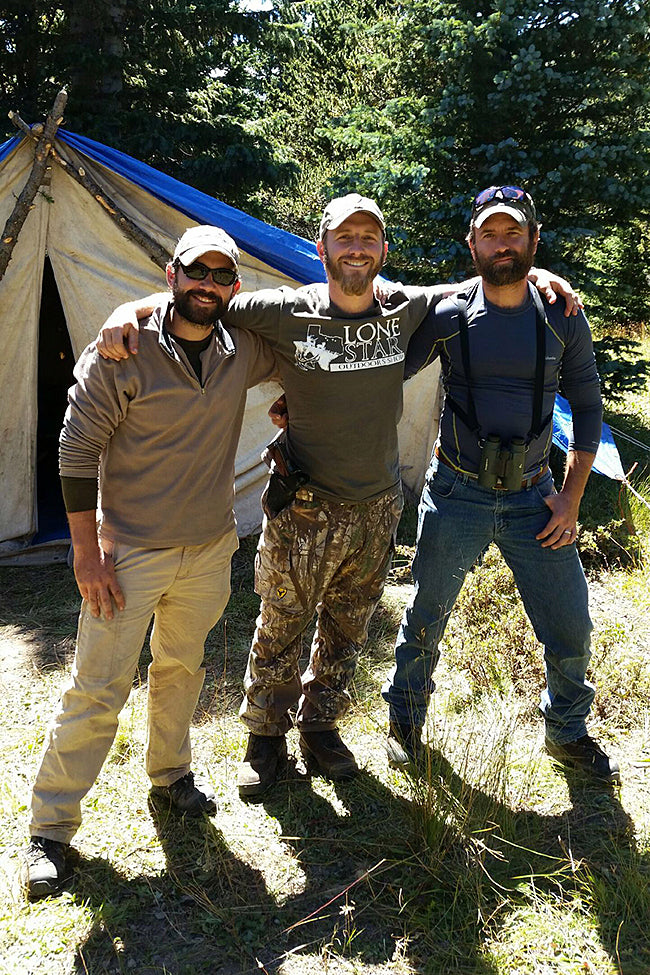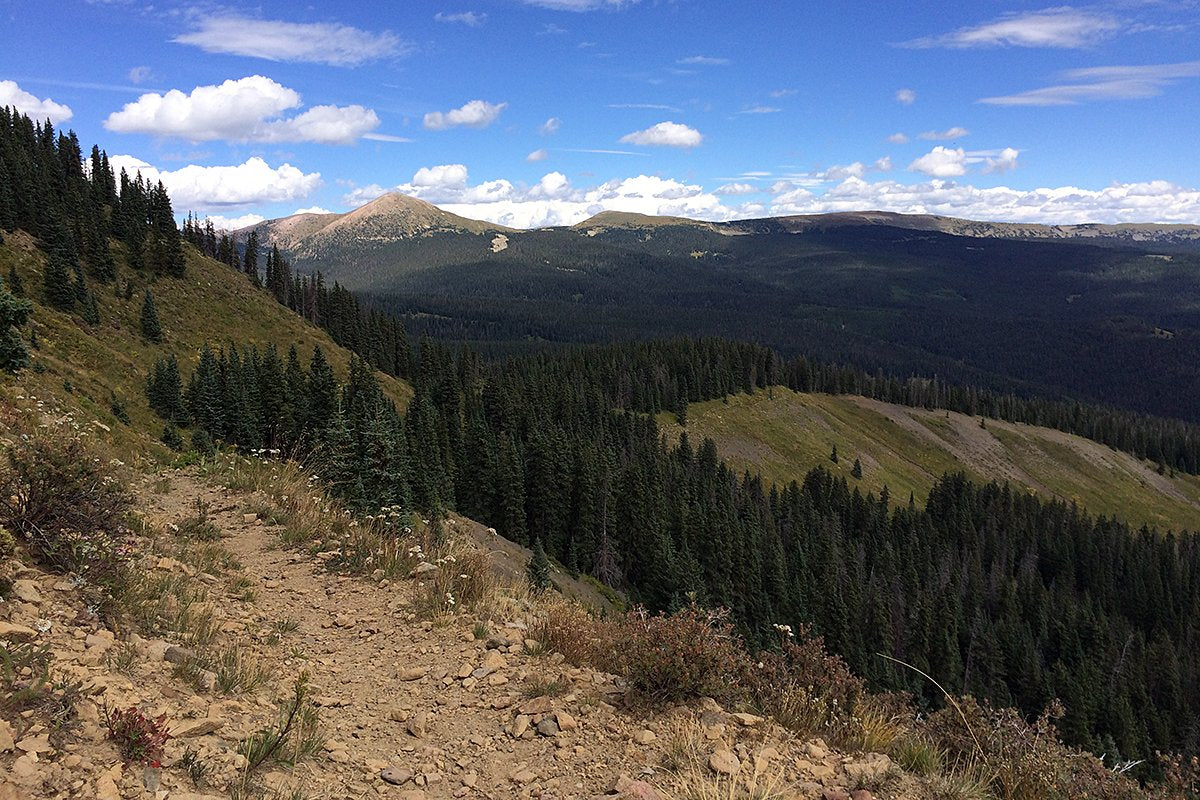
Since the first time I laid eyes on the New Mexican Rockies, the mountains have called to me. That first encounter happened when I was twelve-years-old, heading into the Santa Fe National Forest for my family’s first ski trip. Despite growing up on the flat coastal plains of South Texas―actually, because I grew up a flatlander― the sight of impenetrable forests and jagged snowcaps continued to haunt my thoughts for years to come.
I became a hunter at a young age. Some of my earliest and most vivid memories are of the lessons taught to me by my father and grandfather. But it wasn’t until turning 30 that I picked up my first bow and immediately began dreaming of hunting elk in the Rocky Mountain West.
I poured myself into archery and bow hunting, and four years later decided I was “ready,” so I applied for a New Mexico archery tag in March 2015. I worked my tail off in the gym, at the range, and in my garage bow shop, determined to hike into the mountains a predator. It took over 5 months of preparation and a full workweek of high-country hiking, with several tough lessons learned on the job to accomplish this:
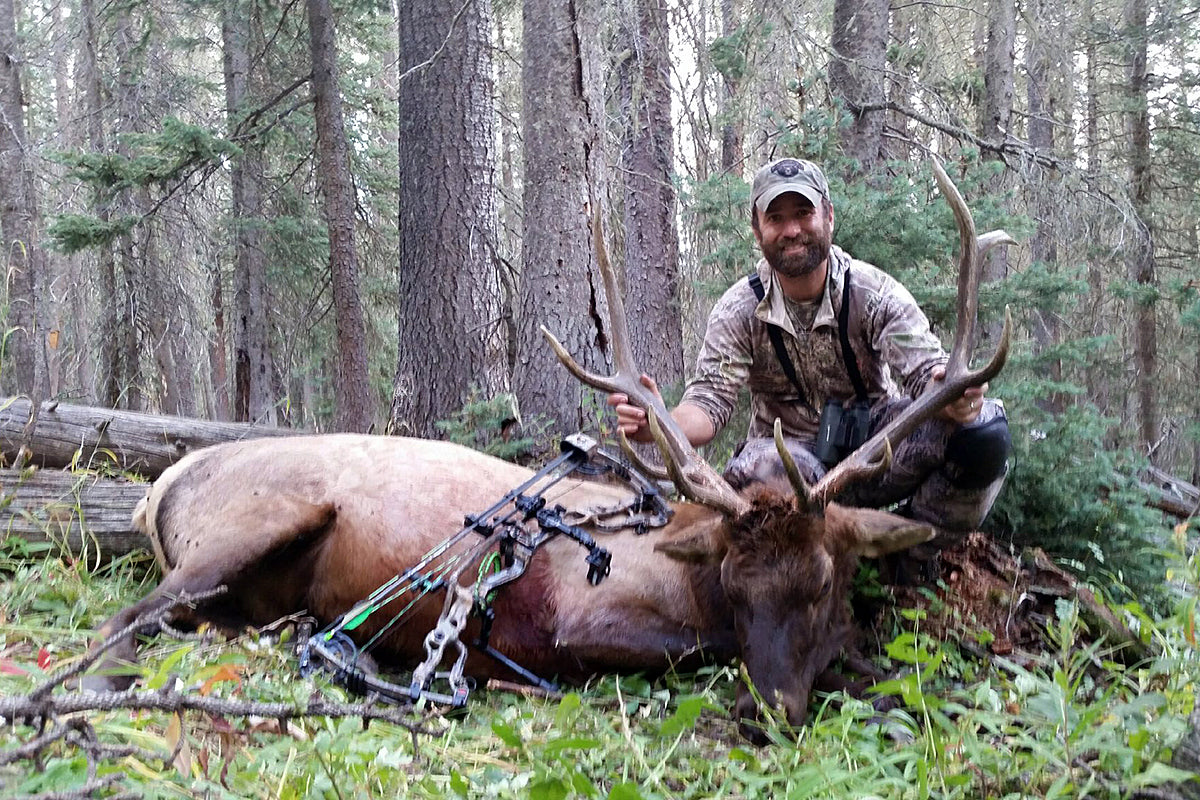
I know he’s young, but I earned him. Anyone who has ever killed a bull in a public Wilderness at 10,500 feet, knows that. On that hunt, three Texas boys came out of the woods with two first-time bulls. It is a week I’ll never forget…
The Journey
I picked up my hunting partners, Cable and David, in Dallas, TX.
We began our 10+ hour drive and passed the time by practicing our calls inside the truck. In no time, we arrived in Las Vegas, New Mexico. Did you know there is a Vegas in New Mexico? I didn’t either, but if you ever find yourself in little Las Vegas, do yourself a favor and stop by Dick’s Liquor and Deli. The place is as cool as the name is eccentric. They have a full restaurant with an excellent one-page menu and a really sharp bar, all of which is housed in a newly-renovated old brick warehouse. Turns out Las Vegas is a pretty hip, artsy college town, and Dick’s is THE PLACE.
After a great meal and a couple of craft beers, we hit the sack, full of excitement — less than 12 hours later we would be heading up the forest trail.
Day 1 — “Location”
We helped our wrangler get the horse string packed up and headed out around 11 am. It had been a long time since I’d been on a horse, so I was pleased to find how easily it came back to me. I couldn’t help but feel an ancestral connection to the horse; I get the same feeling when hunting with dogs―an ancient bond between man and animal forged by symbiotic needs. The ride up was beautiful, with massive scenic vistas, and wildflowers that painted the hillsides with a master’s touch that even Leonardo couldn’t achieve with a thousand strokes.
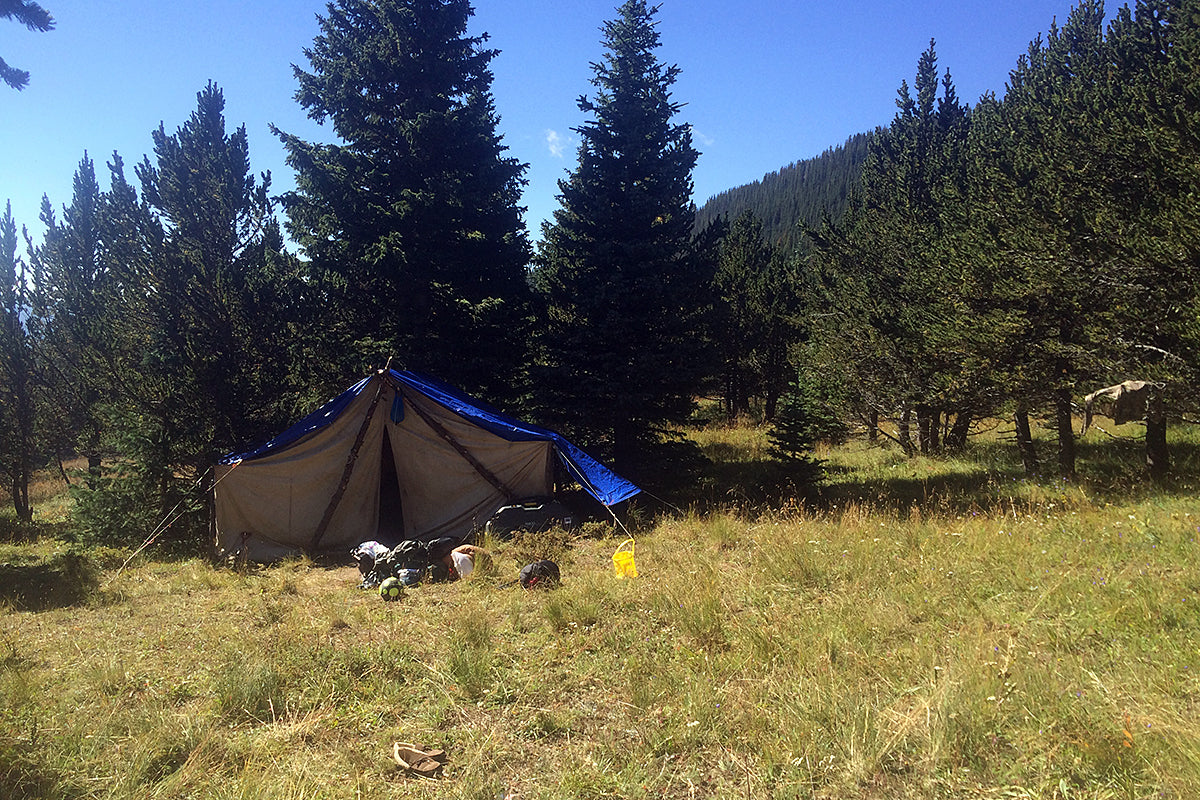
After several hours on horseback, we arrived at 11,400’ and started to setup camp for the week. I’m sure we looked like a NASCAR pit crew as we hurried to unpack and gear-up. Then, like a herd of turtles, we were charging uphill. It didn’t take long before I was sucking wind like a fat guy in spin-class. Despite how winded I was, my buddy Cable was fresh as a daisy. But then I realized I was carrying my frame pack with a 35-pound load, whereas Cable was carrying a daypack load of no more than 10lbs. More on that in a bit….
We soon realized that we had headed up the wrong trail and had to double-back towards camps, so I ditched a few non-essentials and we headed back uphill to the correct saddle that would drop us down into a large grassy valley — an area that would be the focal point of our efforts for the week.
We crossed the top of the valley and started working down the far tree line, and in no time, we had a bull bugling at us. Calling back and forth, we raced him downhill, both parties trying to circle down wind of each other. We went a half-mile down, talking to him the whole way, but when we made our move to cross the valley to get on his side, he must have seen us because we didn’t hear another peep from him. We never got a glimpse of him in that encounter, but we realized later, after a few more encounters, that he had to have been much closer than we realized.
We learned that like a rear-view mirror, bugles in timber are often closer than they appear.
Day 2 — “Friction”
Cable wanted to work the same valley on the second morning. He hunted the area a year prior and saw so many elk there that he found it hard to hunt anywhere else. While it ultimately worked out for him, David and I decided to explore the next two valleys, which ran parallel to the north. At 6:00 am, we parted ways, but before splitting up, David ripped a locator bugle. Immediately, a bull replied to the north. Then another farther north. Then another. A chain reaction of trophies that seemed to validate the plan for David and me.
As we worked northward in the dark, our quarry sounded off from the next ridge. We picked our way and called back sparingly, hoping to hold him there until sunrise. About 30 minutes after sunup, we reached the foot of the far ridge and he bugled for us loud and clear. We guessed he was about 200 yards up the darkly timbered hillside. I slowly bushwhacked into position at the bottom of his hill, and David started calling. Nothing. After about a 30-minute sequence, we moved on. Again, with 20/20 hindsight, we both agree he was much closer than we thought, and he most likely saw or heard me move into shooting position.
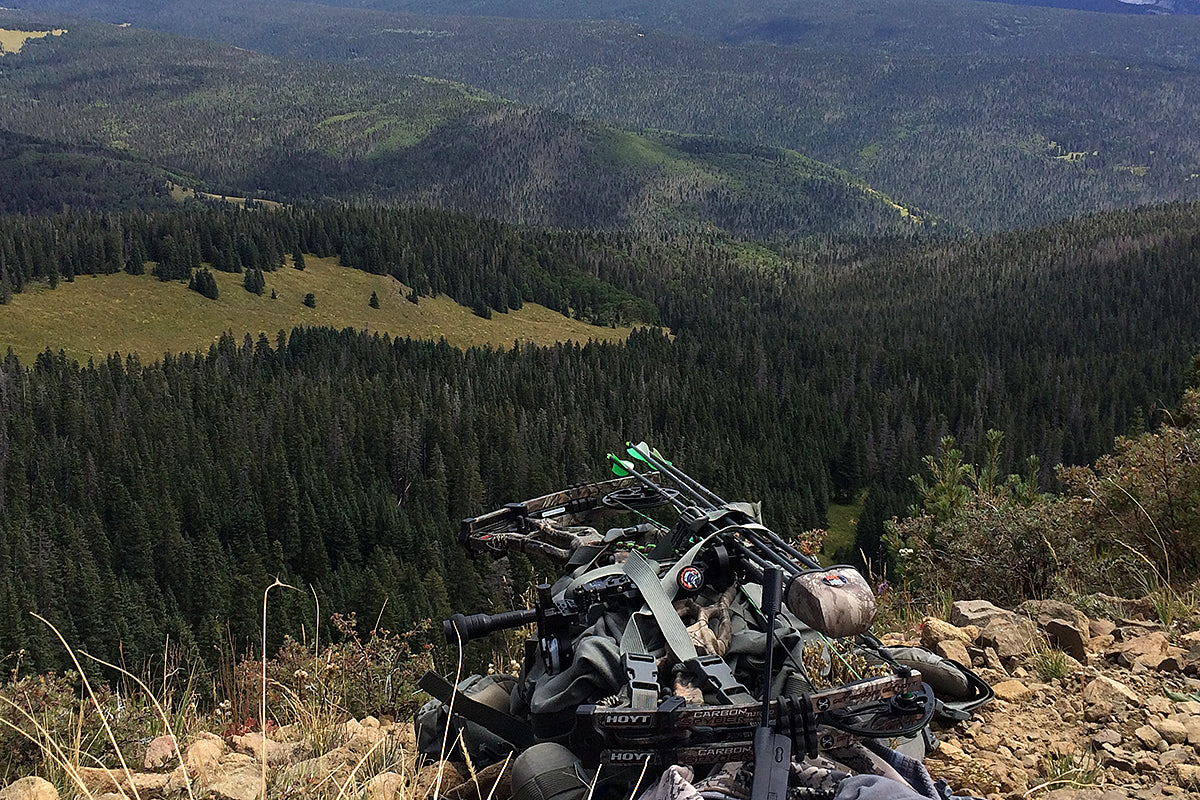
David and I crossed that ridge and started working down the next valley. This guy, David, he is a dang Billy Goat. He basically trots over deadfall, pointing out every rub and turd along the way, while I worked my tail off just to keep up with him! The dude is a true mountain man, and I was blessed to hunt with and learn from him.
After another close encounter with a bull in the timber, we worked our way back to camp to meet up with Cable. We decided to drop straight down into some steep terrain near camp, but found nothing more than months-old sign. The relatively gentle ridges and valleys where we were finding elk were clearly the preferred pre-rut habitat. That lesson only cost us the fare for getting out of there — a thousand-foot climb that, to a Gulf Coast boy, might as well have been straight up.
At this point, I had a fairly serious problem. I apologize in advance for what follows here, but it’s important to the story, a good lesson for others, and pretty funny to boot…
I was wearing merino-wool briefs, which came highly recommended for this style of hunting. I really like them and continue to wear them all the time. I had worn them several times for workouts before this hunt and experienced no problems, but I had never hiked 12 miles in them. Well, after that 12 miles of sweating, they bunched up on me, and after climbing up that cliff face, I had enough friction going to light our campfire. I don’t know if any of the lady readers will have a clue what I’m getting at here, but every guy sure will. Think a LONG day at the beach, in wet and sandy board shorts.
Anyway, we got back to camp right at dark and started cooking. Actually, Cable cooked, and I doctored my “situation,” while trying to move as little as possible. When I did move, I’m sure I looked like a 90-year-old invalid version of Yosemite Sam.
Day 3 — “Action”
The guys headed out a little later than the day before, but still before sun up. I slept-in until 7am, doctored myself, and laid around camp for a couple of hours. I was healed-up by midmorning, so I took care of the camp chores, ditched the wool briefs, pulled my Columbia thermal tights up as high as they would go, put a packet of baby powder in my left pocket, and started hiking up to the saddle. I felt like a million bucks and am very thankful to say that I managed to avoid that “situation” for the duration of our trip.
Due to my “situation,” Cable hunted by himself in a valley that morning and I found myself at the top of it with perfect satellite phone reception when he checked in with me at 1:00 in the afternoon, as we had planned.
The first thing he said to me was,
“Hey dude, you want to come help me find this bull I shot?”
My reply was something like, “Hell freaking yea!”
He told me the shot was about 15 to 20 yards, broadside, and that he had found blood where the bull was standing. Then he said the bull slowly went 20 yards and bedded down. Cable snuck in to get another arrow in him, causing the bull to jump up and run downhill. That second shot was at about 11am, and Cable decided not to track him further.
Before hiking down to find Cable and his bull, I asked God for two things. First, I asked him to help us find that bull. I don’t like asking for help shooting one, but I definitely believe in saying thanks and asking him to help you find one once the shot is made. My second prayer was a selfish one. Knowing that Cable might have scored meat for all of us, I prayed that God would let me get close at least one time. At this point, I had only caught a slight glimpse of an elk. If we found Cable’s bull, and the Good Lord blessed me with just one significant visual encounter, the hunt would be a smashing success in my book.
Prayers said, I started hoofing it. Along the way, I ran into the only other elk hunter we saw that week. I told him I was headed down to help my friend find his bull. A fellow Texan, he felt obligated to lend a hand, and I took him up on his offer on the condition that if we heard a bull while we were tracking, he would go after it. He was there to hunt to, and I didn’t want him to miss an opportunity tracking a stranger’s bull.
The whole way down, I knew I’d need to take charge of the track and make sure to lift Cable’s spirits in the process. Having been in his shoes, I know firsthand how much harder it gets to focus with every minute that passes after arrowing an animal. As I expected, Cable was a little distraught when we got to him. He was calm, but after three and a half hours of second-guessing, he was far from positive about the situation. With an upbeat, workman-like attitude I told him we were going find that bull, and asked him to tell me and show me what happened.
He took me over to first blood, which was so dark it was almost black. That blood, plus bedding down after only 20 yards, screamed liver to me. But I said nothing and stayed positive, only noting that “he must be hurt really bad to bed down right away like that.” The kicker was that we didn’t find any blood where he laid down. Cable had snuck up on him, and actually shot two more arrows. The first was a clean miss and the bull didn’t move―another good indicator that he was in a really bad way. Cable knew the second arrow hit him, but was unsure of the placement. That shot forced the bull to his feet and down a well-worn game trail leading to the creek between the north and south facing slopes.
It was definitely odd that a mortally wounded animal could bed down and not leave a puddle of blood behind, but I was convinced there was no excuse for an animal to take a superficial flesh wound and bed down in sight like that. I told the guys, “If he wasn’t hurt bad, he’d still be running.”
I worked my way slowly down the game trail and found the tiniest spec of blood. Following the trail, we crossed the creek and stood staring up a steep, heavily-wooded face. From the creek crossing, there were four obvious game trails, one downstream, one upstream, one heading up at 10 o’clock, and one at 2 o’clock. I scanned the spot where the four trails merged and saw a hundred elk prints. But there was one that stood out like a sore thumb—a big, heavy hoof print buried deep in the mud. “That’s your bull right there,” I told Cable.
He agreed, and took off down the creek, assuming that the wounded bull would head downhill following the water. We heard a bull bugling, so our new tracking partner took off straight uphill after it. I took a look at the 10 o’clock trail and saw a small diameter log about 10 yards up, with a two-foot long raking hoof mark in front of it. I was 99% sure that a laboring, injured bull left mark. I crawled up the trail on my hands and knees looking for that one speck of blood to confirm my hunch. I reached the first log, and still hadn’t found it, but 10 yards up there was another log with the same raking claw mark. About the time I reached that second log (still no blood), I heard some commotion from downstream so I radioed Cable to see if they had found something. “Nothing,” came the reply, “headed back to the crossing to try again.”
I literally sat there hunched over that log, trying to discern where the trail headed from there, and was about to head back down to meet Cable and try again, when I glanced to my right. This was honestly my exact thought process:
“That’s a funny looking rock. It’s tan colored. It looks kinda’ hairy. Weird. Wait, it’s got a tail! HOLY CRAP THAT’S CABLE’S BULL!!!”
The beast had barely made it 40 yards up the hill, maybe 100 yards from Cable’s initial shot. I started hollering at him to get his butt up there quick. When he did, we both hit our knees and thanked God, and the work began. Thankfully, David just happened to walk by and heard us from across the creek so he helped butcher and pack the elk to the trail, where our wrangler would pick him up the next day. I should probably mention here that while David and Cable routinely found themselves waiting on me as I huffed and puffed, they were very glad that I had my frame pack and my typical 25 pounds of gear, otherwise they would have had a loooong hike up to camp to gather necessary gear for processing and packing, and then back down to the bull to do the job.
David proceeded to tell us about several encounters he had earlier that day, including a nice 6×6 that never stepped out from behind a tree to provide a clean shot. While skinning the last hindquarter, he found Cable’s broadhead. The bull was quartered toward Cable more than he realized, which made sense, considering he was calling by himself. The sharp angle resulted in a liver shot, but the arrow passed all the way through the bull’s body and buried in the back hindquarter, severing the femoral artery. Another half-inch and it would have poked through that hide, leaving a blood trail you could have seen from the international space station.
The shot was absolutely devastating. Liver alone would have taken him down eventually, but we might not have found him. The massive damage to that back-side hind quarter is what caused him to bed down immediately, where he would have bled out internally in less than 2 minutes. That’s also what caused the heavy hoof print by the creek and the claw marks. Each time he tried to step uphill over a log, that back hoof would slip out from under him.
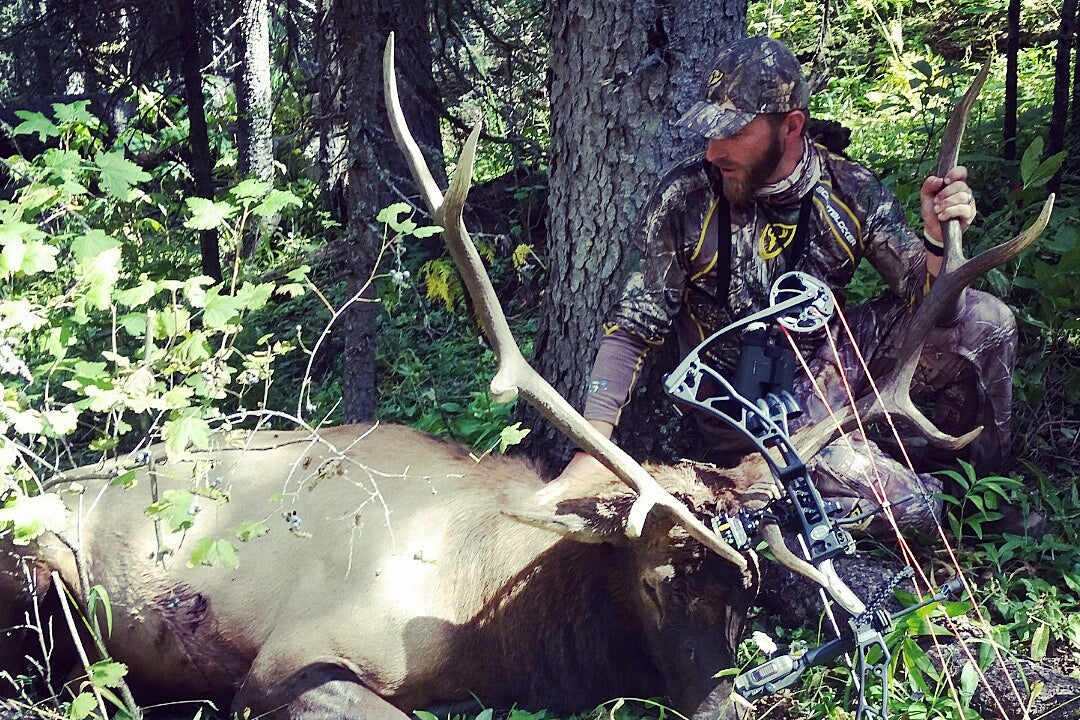
After a good 3 hours of butchering, packing, and hanging meat, we headed uphill. We agreed to divide and conquer — David hunted his way up the valley floor, while Cable and I took the hiking trail to see what might be at the top. Within minutes of arriving at the bottom of the highest meadow, Cable spotted something coming out at the very top. It took one look through glass to know that the herd bull had arrived.
Cable and I argued over how to set up on him, and ultimately ended up staying put. We were on the north side of the valley, probably 70’ above the valley floor. The bull was steadily working his way down, bugling furiously every time Cable called. I positioned myself about 20 yards upwind of Cable, just in front of the trees he was calling in. Expecting the bull to work his way along the valley downwind of us, I crawled over to the edge so I’d have a shot at him. I didn’t expect him to climb straight up the valley wall right at us, so of course that’s exactly what he did. Crouched in probably 3 feet of high grass, the first thing I saw were whale tales swaying as he reached the lip of the drop off. About then, a spike came bouncing out of the woods right at me; he got to 3 yards, spooked and ran down hill, causing the herd bull to hang-up with a bewildered “dumb kid” look on his face.
At this point, the big 6×6 is probably 15 yards away, but the meadow grass is blocking my view of his body. All I could see was his head and MASSIVE antlers. I didn’t have a shot. Another bull started raking a tree in the woods to the right, and when the herd bull would look that direction, he’d turn his head enough that I thought I might be able to draw and stand up without him busting me immediately. Every time I’d start to draw, Cable would call, causing the bull to turn and look in our direction.
He started to move to us, and when he made it to 8 yards, I decided to go for broke. I drew my bow and stood…
As expected, he broke immediately, so I chased him to the lip of the drop-off and tried to get my pin on him as he stopped briefly in the bottom of the valley. To this day, I’m not sure that I would have tried to take that shot. It would have been pure guesswork, so I’m actually thankful that he took off again before I got my sight and peep aligned. I stayed pretty calm during it all, but as soon as he disappeared into the woods, I dropped to my back hyperventilating. Being on the ground, 8 yards from a dominant mature bull elk without a tree to jump behind is a hair-raising experience to say the very least.
We headed back to camp, cooked up a fresh elk tenderloin and had a celebratory hot toddy to honor Cable’s kill. Then we hit the sack.
Days 4 and 5 — “Frustration”
I’m going to breeze through days 4 and 5, because they aren’t particularly memorable, and there is one part we’d all just as soon forget.
We chose to sleep in a bit, because having positioned our camp up high, almost all of our action had been between about 10 am and 2 pm as the herd moved to the bedding areas. It had nothing to do with the hot toddies…
About mid-day Cable and I got a radio call from David. He had stuck a bull, but could tell he didn’t get very good penetration, so he had backed out a few hours earlier and headed back to camp to grab his frame pack and kill kit. He was fairly close to us, so we met him along the trail and headed for first blood. We tracked him until dark and called it a day. David tracked that bull for over a mile and a half (as the crow flies) over the next two full days and never found him. David is hands-down the best hunter I know. It’s a shame that he, of all people, would have this happen. But I guess it would be almost unheard of for three Texas flat-landers to go into the elk woods and come out with 3 bulls. Something had to give, and it was David that drew the short straw. At least he had his 300” 6×6 from the year before to look at when he got home, plus his share of the meat from this trip.
Suffice it to say, my Wednesday was shot. Thursday wasn’t much better. Cable and I worked a massive 11-mile loop, bushwhacking all over the area that David had been hunting, as well as the next ridge to the north. As we climbed the main valley that evening, I was dejected. My feet were killing me, and I had the sinking feeling that we had probably over-stayed our welcome. We had worked the area hard, and after 3 days of constant bugling and numerous encounters, the woods were silent. Those two days, Cable and I heard exactly two bugles. Both were around 2 pm, and both were almost exactly where we had found Cable’s bull lying.
Late on Thursday evening, we approached the top of the high meadow along the main hiking trail, which swept out toward the valley wall. As I reached the ledge, I spotted a cow in the valley bottom, and dropped to my knees. Cable, behind me, dropped as well. A switch flipped in my brain ― I was going to get that cow. I started my stalk, despite having zero cover whatsoever. I closed from 80 yards to about 65, and thought seriously about aiming high with my 50-yard pin, but thankfully (again) she bolted. And so did I.
I sprinted straight down the valley wall, bow in hand, arrow nocked and tipped with a razor sharp broadhead, jumping over crevasses that were 2’ wide and 2’ deep.
I remember feeling like Daniel Day Lewis from Last of the Mohicans but when she hit the tree line, I turned around, looked at the 50-foot wall I had to climb, and suddenly felt more like Jerry Lewis. Turned out that David was at the top of the valley watching this scene play out after having tracked his bull all day ― I was glad to have given him a good laugh. He did give me props for my moves though.
Back at camp, we talked over what we had learned through the week. For two days leading up to his shot, David had worked the ridge that ran along the north side of the main valley, calling in 8 different elk. Cable and I had walked all over that ridge, seeing for ourselves what it looked like on the ground and why it was holding elk. That ridge was convenient, because it had a hiking trail running right down it, unlike the ridge to the south of the main valley, where we had watched the herd bull come out, where Cable’s bull had fled and died, and where we had heard the only two bugles the last 48 hours. The only way across that ridge was to bushwhack through some gnarly wilderness deadfall. It was unspoiled, and looking at the topo map, it was virtually identical to the north ridge, only a bit narrower. We knew if I was going to find a bull, that’s where he would be. Somewhat rejuvenated, we crashed.
Day 6 — “Elation”
Before that cow encounter the day before, I was ready to quit. I told Cable all I wanted to do was sit at the top of the valley Friday evening and see if that big 6×6 would come back out, but he refused. His bull had been on ice for three days and his feet were killing him too, but he wouldn’t let me hang it up. All summer I had pushed him to hit the gym and shoot his bow, now he was pushing me when it mattered most.
We dragged ourselves out of bed. Our last-ditch ridge was actually the closest one to camp. We had walked right by the head of it multiple times each day, but to get to the area where we expected to find the elk ― somewhere around 10,500’ of elevation ― we first had to bushwhack over a peak that rose over 12,000’. Being alpine-transition, it was easy hiking. Then on the backside as we started heading down the ridge, we found ourselves in an old burn. You couldn’t see it from any vantage we had during the week, and I didn’t notice it on the satellite images while desktop scouting earlier in the year. We worked our way through it, and around 10:00 am, just when I was starting to regret sleeping in, 3 bulls lit up the forest below. We had reached the edge of the burn, with dark timber just 60 yards ahead, around 10,800’.
To avoid over-pressuring our last remaining sanctuary, Cable and I had agreed not to call until we heard elk. The night before, David had taught me the Lost Cow and Assembly mews, so I gave the sequence a try. One of the bulls immediately responded to my Lost Cow, and then fell silent when I followed with the Assembly. Even though David told me the Assembly Mew would not get a vocal response, I couldn’t help but worry that I had spooked him. I stuck to the plan, giving him a minute or two before trying the Lost Cow again ― he bugled right back. This time I was able to pinpoint his direction, and knew he was hoofing it our way. I worked downwind and away from the call, leaving Cable about 45 yards uphill, behind me and to the right. I worked the call sequence, with Cable throwing in a soft calf mew here and there, which together must have sounded pretty realistic at this stage of the pre-rut.
The last time we exchanged calls, I knew the bull was real close, so I signaled at Cable to bugle. The response we got was incredible. He went from a very casual “How you doin’?” to a very hostile “You talkin’ ta me?” I think the delayed introduction of another bull only added to the realism. For 5 minutes, this dude was chatting with a lost cow and her calf, but all of a sudden, someone had beaten him to the punch. He sounded…pissed!
The bull was about 70 yards downhill, heading in my direction but working downwind of us. Even though I had stopped calling several minutes earlier, he was still working to the last place he had heard that cow call. He closed the distance to 20 yards and I drew my bow while hiding behind an old burned tree. He continued to close the distance, working from my right to left, but pausing briefly when he heard one of Cable’s calls. At roughly 10 yards, I knew he would either continue moving to my left, where I could shoot before he got into my wind, or he would turn up to go see Cable, bringing him to my right, requiring me to pivot around the tree.
He finally committed to Cable’s calls. I pivoted around the tree, just as he cleared it. He caught movement and busted, but only at a trot. After my experience with the big herd bull, I knew what to do. I told myself,
“Get in your peep, line up, and put your pins on him. The calls will get him to stop, it’s just a matter of when. Be ready….”
He trotted a few more yards and then slowed. In “full-draw” time, it seemed like he was standing there for 5 seconds as I pulled through the shot. Cable’s fish-eye video shows that he barely paused ― like a “roll-through” traffic stop ― before my 486 grain arrow smashed him. He ran off with only my fletching sticking out of his armpit. Bullseye!
The bull started to waiver after about 20 yards, but composed himself and walked downhill. I circled around behind him, and he stopped to look back at me. Cable had asked me earlier in the week if he had made a mistake by taking those shots while his bull was bedded down. I told him, “No, I would have done the same thing, but you should have ranged him first. You rushed it, and the downhill angle caused you to shoot high.”
Here I am, in basically the same situation, with my darn range finder readily accessible around my neck and my bull fading fast, and what do I do? Nock an arrow, put my 50-yard pin on him, and let it rip. I skipped it off his back and he ran further downhill.
Thankfully, I heard him crash just seconds after that shot. But truthfully, I knew when I took the first shot that he was a dead elk — my arrow was perfectly placed and went deep. Still, I should have heeded my own advice. Yet another lesson learned.
Out of an abundance of caution, we made ourselves give him 45 minutes. We talked through the whole event, with Cable rolling film, and when I couldn’t stand it anymore, we started tracking blood. I could not have asked for more from my 125 grain Strickland Helix broadhead.
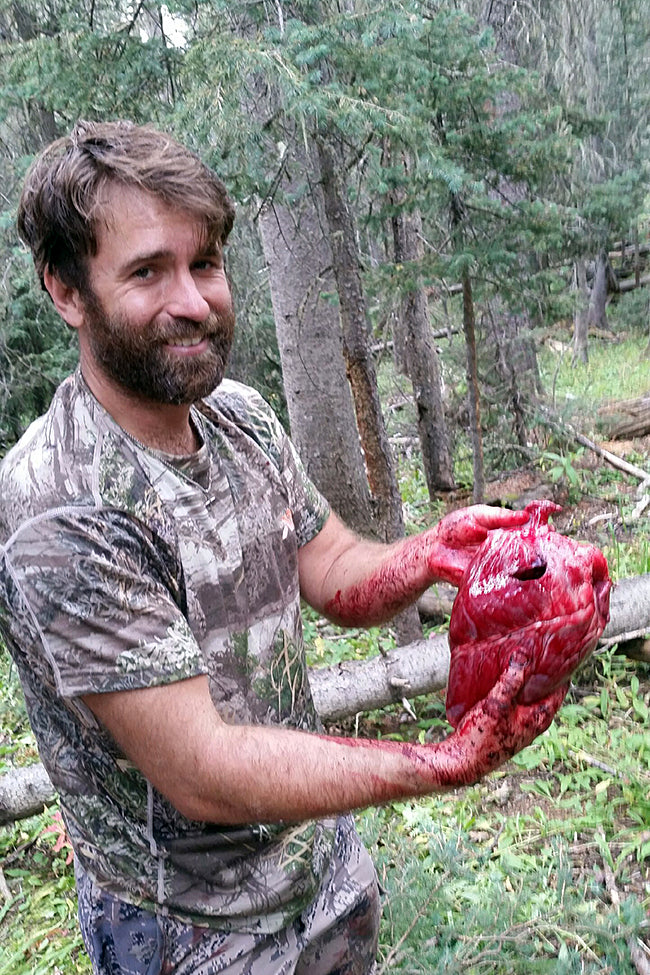
After 5 months of hard work, a crash course in bow tuning, and 6 days of life at 11,000 feet, I had executed a perfect heart shot on my first bull elk.
It took 2 trips and 5 full pack loads to get him to the trail, where our wrangler met us to pack him out. (Thankfully, David found us after the first trip. That dude always shows up right in time!) It was about 2/3rds of a mile each way, steeply downhill and then back up. My last load easily exceeded 100 pounds.
As icing on the cake, we got to experience the sight of the herd bull at the top of the valley on our way back to camp that night. By that point in the week, he had assembled his harem. He stood in the valley floor, furiously pacing back and forth and screaming at us, as we taunted him with raspy bugles from the timber on the south-facing slope. We managed to get some video of the old warrior before dark. It was an incredible way to cap off an amazing week.
